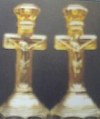Westmoreland - Part 2
WESTMORELAND - Part 2
In the Beginnning:
In 1889 a group of investors took the risk of founding a glass company which became known as the Westmoreland Glass Company of Grapeville, PA. Their successful history spanned nearly 100 years. These intrepid individuals did more than start a glass factory - they touched all our lives by giving us the beautiful handmade glassware we collect and cherish today.
Much of the history that has been published about Westmoreland Glass may have been taken from two letters. One letter was from the hand of A.J. Stevenson of the Specialty Glass Co. of Liverpool, Ohio. The other letter was written by James H. Brainard, former president and owner of the Westmoreland Glass Co.
Built in the rolling hills of PA, there is speculation that the most probable reason for Mr. Stevenson purchasing the land at Grapeville Station was the abundance of natural gas on the property. Natural gas is a necessary element in glass manufacturing. Close proximity to the Pennsylvania railroad enabled him to obtain raw materials easily, as well as to ship the finished product. With ample shade trees to cool the grounds, and a supply of pure spring water, the ideal spot had been found.
As an incentive to move employees and their families to the site of the new plant at Grapeville Station, the acreage was divided into 105 lots. Free gas would be furnished at no cost for lighting and heating as long as the supply would last, estimated to be 20 years.
As people began relocating to the area, the construction of the plant got under way in Oct. of 1889. The first glass was produced in 1890.
A few years later, the plant was purchased by two brothers, Charles H. and George West, from A.J. Stevenson and the Specialty Glass Co. Financial support was provided by Ira A. Brainard. Westmoreland Specialty Co. changed hands again when in 1920 tension between brothers arose and George West sold his interest to Charles West and Ira Brainard. In 1923 the name was changed to Westmoreland Glass Co.
The great depression forced Charles West to sell his interest to the Brainard family, who reorganized the company with James J. Brainard as president. After his death in 1953, his son James H. Brainard succeeded him, with his brother Walter M. Brainard taking the position of vice president. In 1981 ownership was purchased by Dave Grossman. On May 21, 1984 the flame at the Westmoreland Glass Co. was finally extinguished. A lifespan of nearly a few years short of a century had ended.
The following is a letter by J. H. Brainard
Historical Sketch of Westmoreland Glass Company
A copy of the earliest record is herewith enclosed, and it indicates that in the Spring of 1889 a group of men operating the Specialty Glass Company in East Liverpool, Ohio, migrated to Grapeville because of Gas being on the property where our plant is now located. In Oct. of 1889 construction of the plant started and actual production occurred in early 1890.
My Grandfather, Ira A. Brainard, lived in Pittsburgh, about 25 miles west of Grapeville, and had many interests. He was instrumental in financially helping two sons, with a widowed mother, participate in the development of the factory here at Grapeville. The men from East Liverpool sold out their interest in the very early 90s and the two West brothers, backed by my grandfather's finances operated the plant successfully until 1920. At that time, friction developed between the West brothers, and one sold his interest to the other and my grandfather.
In 1924, it was voted to change our name from Westmoreland Specialty Company to WESTMORELAND GLASS COMPANY, as the former had become somewhat of a misnomer because they began to get inquiries on many different types of products, going so far as Flat Silverware for use in the Railroad's Pullman Dining Cars. I believe that even a request was made for Guns during World War I. By that time, people began to feel that we manufactured most any item. Actually, glassware was the only real item manufactured, although early in the 1900's many, many condiments, such as vinegar, mustard, baking powder, lemon flavor, etc. were processed here, but it is difficult to say whether such things were supplied in the containers for the purpose of selling the glassware or the condiment involved.
During World War I many glass items contained candy and were distributed by the News Stands and Dime stores throughout the country. Such diversification was not profitable because, as mentioned above, glass was the primary product of the Company. It was of high quality, manufactured by hand from the Pot Furnaces. Milk Glass, such as our Hens and other pieces illustrated in the current catalog, was probably the outstanding material produced, although in the 1920's we did make some high quality decorated ware and crystal. We still manufacture some decorated ware in addition to Colored Crystal such as Amber, Blue, Green, Pink and Brown. During the last thirty years, our manufacturing has been 90% Milk Glass, and the quality today is undoubtedly superior to that of years ago. In the years following the Civil War, there were a number of Milk Glass producers in the Pittsburgh, Pennsylvania area, and one of the outstanding plants was the Atterbury Company. They made high quality Milk Glass and our company came into it a year or so after they went out of existence. So, in a sense, we carried on where they left off.
During the depression in the 30's, our Company like many plants, was badly hurt, but we never stopped operations and re-organization took place in 1937 after the West financial interest became worthless and considerable investment was being risked by the Brainard interest. My father, James J. Brainard, who joined the Company in 1920 as treasurer, became President in 1937. I took over as treasurer after joining the Company in 1933 following graduation from Yale University.
My father's death occurred in 1953, and I became President of the Company shortly afterwards. My grandfather died in 1927.
J.H. Brainard, President

Taken from a 1985 issue of COLLECTING GLASS by Wm. Heacock
December 1907 Assortment of Westmoreland's competition line in Filigree:
(Text- in part- from 1985 issue of COLLECTING GLASS by Wm. Heacock)
“Apparently The Westmoreland Specialty Company, Grapeville, PA., which is known for its versatility in competing with other factories' new lines, (namely Dugan), introduced its own Filigree line. A Fall, 1907 Butler Bros. catalogue shows this assortment of imitation silver overlay. Included in this group is a design named ESTATE, with a creamer pictured. The Westmoreland variant can be found in clear glass with gold or silver on the raised design. It is also known in all clear, marigold iridescent, and in an odd bluish-purple stain with an iridescent surface. A few rare pieces have been reported in a light aqua iridescent and in peach opal carnival.
The Westmoreland firm appears to have been involved in the production of carnival glass only a few years, from about 1909 to 1912, but to date a mountain of circumstantial evidence is all we have on which to base these conclusions.”
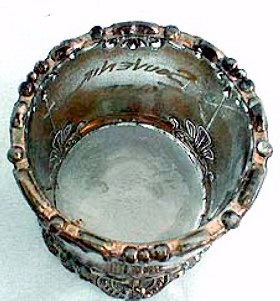
SIMPLICITY SCROLL Cigar Holder
SOUVENIR Toledo print is pretty well worn off, but Souvenir is visible.
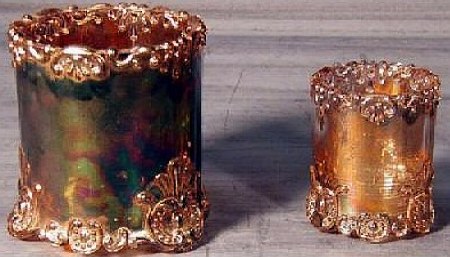
SIMPLICITY SCROLL Cigar Holder 3 in.high x 2 and one-half in. wide.
Toothpick 2 in. high x 1 and three-fourths in. wide.-- RARE-RARE pieces!
SIMPLICITY SCROLL Cigar Holder and Toothpick: Certainly not your everyday “find”, but these appeared on Ebay in early Jan. '05, with absolutely no instant response. Final bid price - $ 20. ! Another “rare-so-what”, for lack of information to collectors. The unknown factor creates “hesitation”. If these were as prevalent as Peacocks, price and acceptance would compensate.
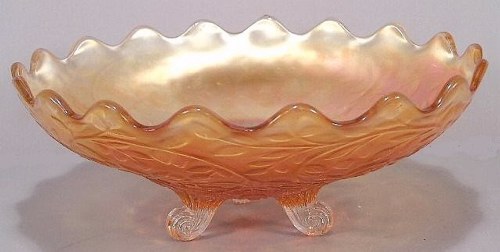
LOUISA Bowl - 8.5 inch
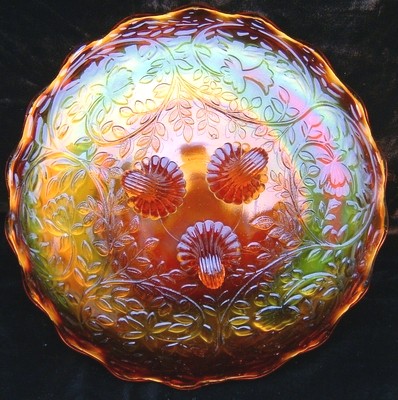
Nine inch LOUISA plate in amber
LOUISA footed plate: Rosebowls in this exterior, allover floral and vine design are seen quite often. Prices for this shape are more reasonable than for most rosebowls, and the color array includes amber-yellow, amethyst, aqua, blue, green, horehound, lime green, mmg, teal and vaseline. A nut bowl shape with sides more or less upright are known in amethyst, green, and teal. Footed and ruffled bowls in aqua, marigold, peach opal and teal can be found, along with 9” footed plates in amethyst, marigold, teal and purple.
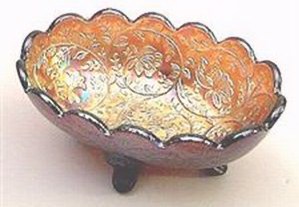 |
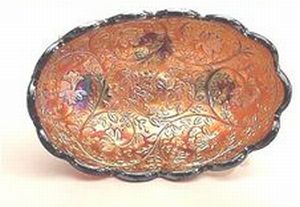 |
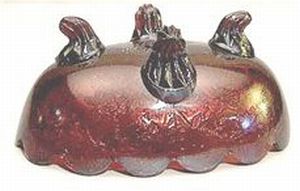 |
|
LOUISA Sauce Dish - five and three-eighths inch
|
|
LOUISA SAUCES: The extremely scarce footed, oval sauces are quite nice and desirable because the Louisa pattern appears on the interior surface! These sauces are known in amethyst, marigold and teal colors.
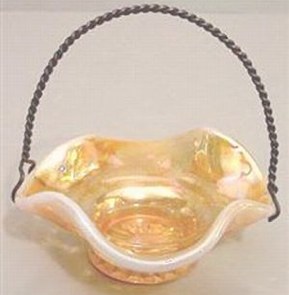 |
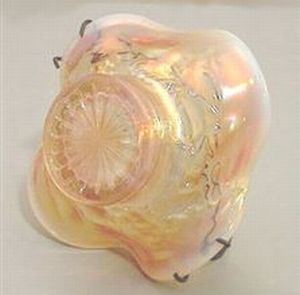 |
MINIATURE INTAGLIO FLOWER BASKET by Westmoreland
3 3/4 by 1 1/2 inch deep
|
|
MINIATURE INTAGLIO FLOWER BASKET: This charming little basket complete with wire handle, easily detachable, but quite lovingly left intact over the years by careful collectors, is verified as provided by manufacturer, when we look at the accompanying Butler Bros. ad.
This basket was used for “souvenir lettering”, such as “Souvenir of Nekoosh, Wisc.” Pattern is intaglio, rather than raised, found in peach opal. The glass is surprisingly thick for such a tiny piece - 4 ¼” in diameter, and only about 1 ½” deep. Not a detailed pattern, but graceful and well-suited for the purpose. Vines, buds, and possibly a wild flower design entwines itself around the underside of the basket. There is a star design within the marie.
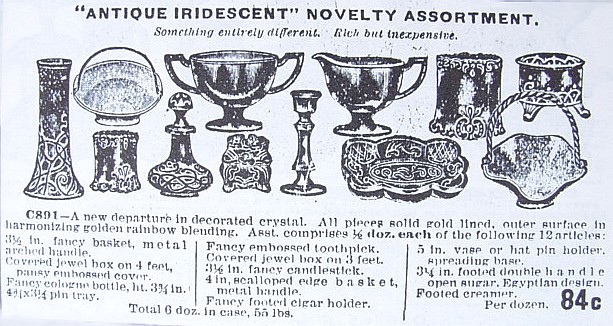
FALL 1908 Butler Bros. Ad displays the SIMPLICITY SCROLL Cigar Holder and Toothpick.
Butler Bros. Ad: Fall 1908: Sitting among other known Westmoreland items, the little flower basket is known to have been among the very early products, along with Estate items. Notice should also be taken of the two Simplicity Scroll items we picture in this segment. All Westmoreland patterns are considered scarce to rare in today's world of collecting.
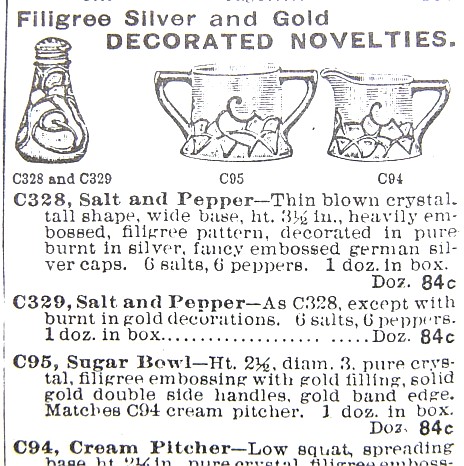
Spring 1908 Butler Bros. ad showing ESTATE pattern
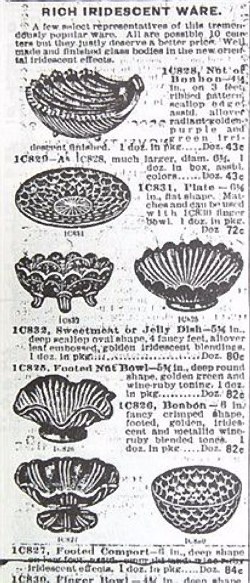
Oct. 1909 Butler Bros. Catalog ad verifying SCALES, FOOTED SHELL, and LOUISA,
as shown in accompanying photos.
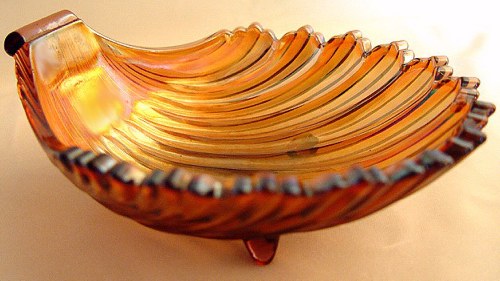
Large Footed Shell
Two sizes were made in these FOOTED SHELLS
4 1/2” and a 6 3/4”
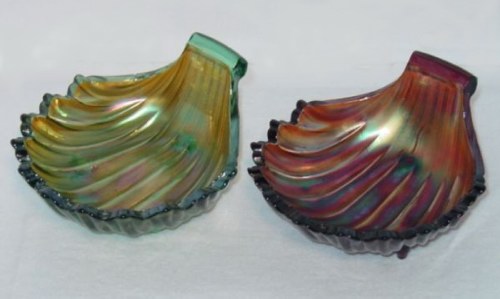
Small Footed Shells in Green and Amethyst
FOOTED SHELL: A 4 1/2” and a 6 3/4” size was made in this novelty. The smaller size is especially difficult to obtain. There are three tiny pointed and stubby feet upon which the shell rests. Iridization is on the inside only. Colors are amethyst, green, marigold and blue, along with an iridized milk glass.
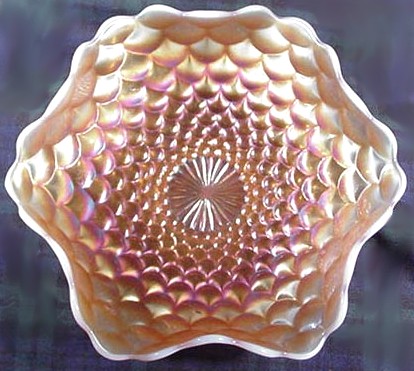
Peach Opal SCALES
SCALES: Not to be confused with the Dugan pattern called Fishscale and Beads, this pattern portrays (raised) scales, rather than (indented) ones, as do the Dugan version. 9” bowls in blue opal, mmg, and peach opal, 6” bowls in amethyst, 8”-9” plates in mmg and peach opal, 6” plates in amethyst, aqua, marigold, and teal, and banana dishes in peach opal are known in this pattern. Some of the better examples in blue opal bowls have been known to bring in the neighborhood of $400.
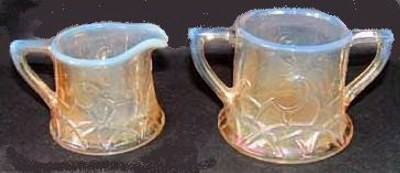
ESTATE Breakfast Creamer and Sugar in Peach Opal
ESTATE: Small pieces comprise this entire line of offerings, and they are fairly numerous so far as shapes are concerned, although few of them appear at carnival glass auctions. These Breakfast Sets are found in blue opal, peach opal and marigold, smoke, and amethyst.
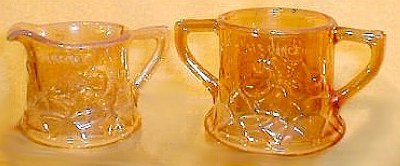
This marigold Breakfast Set of ESTATE is 2.5 in. tall. Souvenir of DeKalb Junction, N.Y.
ESTATE set in marigold: displays lettering. “Souvenir of DeKalb Junction, NY”.
Other shapes available in this classic pattern:
For More Info Please visit:
Dean & Diane Fry - 1/05
Cast your burden on the Lord, and He shall sustain you. ~~Psalm 55:22
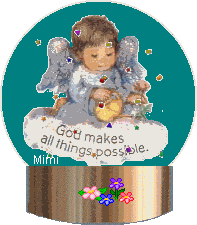
Should you care to contact the Frys, their email address is:
Search Our Sites
back to Carnival Glass 101
Our other sites you may enjoy:
Everything you EVER wanted to know about Indiana Glass
Great Reference for Newer Carnival Glass.
Complete Glassware Catalogs Available to Download
Questions? Comments? Suggestions? Broken Links? Corrections?
Your Friendly Webmaster is here to help!
